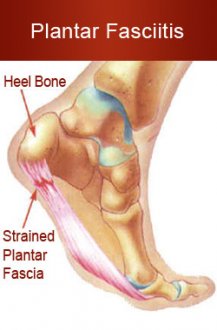Common Running Injuries - Plantar Fasciitis
- Category: Blog
- Posted On:
- Written By: David Kandel, PT, OCS, CSCS

Pomona Valley Hospital Medical Center Physical Therapist, Orthopedic and Sports Injury Specialist
Athletes in and around the Pomona Valley area are preparing to run the Holiday 5K and Half Marathon at the Pomona Fairplex on December 10-11, 2016 (register here:www.runholidayhalf.com), and Pomona Valley Hospital Medical Center’s Rehabilitation Services team is ready help you with your training needs!
One of the most common injuries seen in runners is plantar fasciitis, also known as Runner’s Heel. Approximately 10 percent of all runners will experience this injury throughout their athletic career. So, what is plantar fasciitis?
Plantar fasciitis is a painful inflammation of the plantar fascia (the fibrous tissue that supports the arch of your foot). It is often caused by repetitive microtrauma, sometimes as a result of running or walking greater distances than one is accustomed to, but can also result from the daily prolonged standing that is required in many occupations. Shoes that lack adequate arch support may also contribute to the development of plantar fasciitis, or hinder recovery.
The primary symptom of plantar fasciitis is pain in the bottom of the heel or arch of the foot with standing and walking activities. Pain tends to be worse with standing or walking after prolonged periods of inactivity, especially first thing in the morning.
Like most inflammatory conditions, it is necessary to decrease stress to the inflamed area. This is accomplished by trying to limit the amount of repetitive weight-bearing activities such as walking, running and jumping. Using ice for 10-15 minutes 3-4 times a day is beneficial during the acute phase of plantar fasciitis. The best way to ice the bottom of your foot is to freeze a plastic bottle of water, place it on the floor with your foot on top and roll your foot back and forth over the frozen bottle. This will cool, stretch and massage the bottom of the foot.
Stretching and strengthening exercises may facilitate recovery and help to prevent future flare-ups. Stretching the calf by pulling the foot back with a towel, and stretching the plantar fascia by pulling up the big toe with your hand, can help improve flexibility and reduce stress on the plantar fascia. Performing a few of these stretches for 2-4 minutes before stepping out of bed can help to reduce the pain with standing and walking first thing in the morning. Strengthening exercises should include standing heel raises and toe gripping. Toe gripping is performed with your foot flat on a towel on a hard floor. Then flex your toes to “scrunch” up the towel under the toes. After about 10 repetitions, stretch out the towel and start over again. Repeat the cycle 10 times. This exercise helps strengthen muscles that support the arch of the foot.
A night splint can also be worn while sleeping to keep the foot in a position that gently stretches the plantar fascia to prevent resting all night with these tissues in a shortened position. Night splints can be custom fitted by your physical therapist, or “off the shelf,” splints are available from medical supply or foot specialty stores. Use of a night splint will usually significantly reduce the pain of walking first thing in the morning and will facilitate healing. In my own experience with plantar fasciitis, in the first few weeks after onset, I felt severe sharp pain under my heel as soon as I got out of bed every morning and began walking. As soon as I started using a night splint, that sharp morning pain almost completely went away. I tried wearing a rigid custom-fitted night splint and also used a soft splint called the Strassburg sock. I found that both types of night splint were equally effective.
Finally, the choice of footwear is critical. Shoes with proper support and cushioning should be worn for any extensive walking or running activity. Some specialty walking or running shoe stores have well-trained staff who can help fit you properly. Additionally, off-the-shelf orthotic inserts can be an inexpensive option for achieving good support. Visit your nearest athletic shoe store and get a proper fitting on your running shoes or insoles.
Consult your doctor and get evaluated by a physical therapist if pain continues for more than two or three weeks. Patients often do not see me until they have been suffering for months and at that point, recovery usually takes much longer.
For more information on the services and programs offered by Pomona Valley Hospital Medical Center’s Rehabilitation Services Department, including four locations in Pomona, Chino Hills, Claremont and Covina, visit:www.pvhmc.org/rehabilitation.



